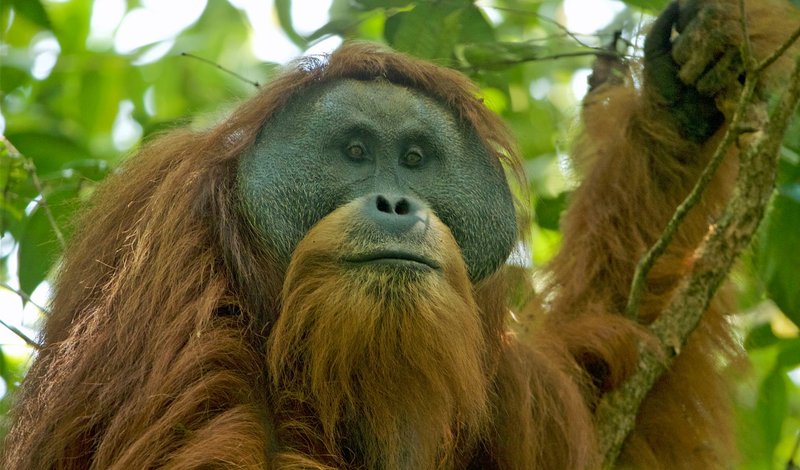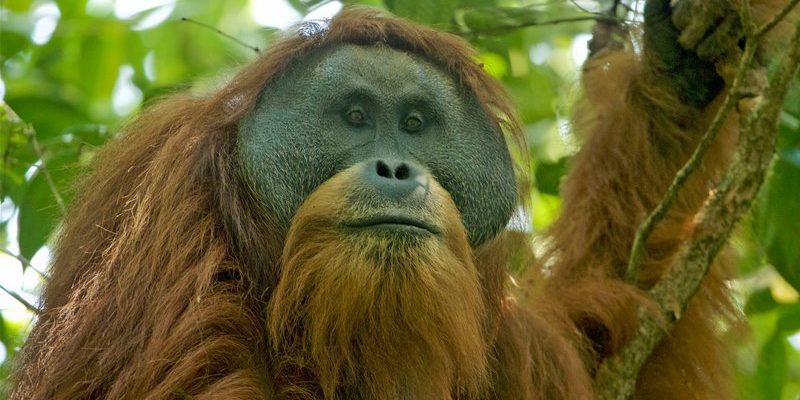
Located in the remote mountains of Sumatra, Indonesia, the Tapanuli orangutan is the world’s rarest great ape, with fewer than 800 individuals left in the wild. Sadly, they’re threatened by habitat loss, which makes understanding them all the more important. So, let’s dive into some of the most common myths and misconceptions about the Tapanuli orangutan and clear up any confusion.
Myth 1: The Tapanuli Orangutan is Just Another Type of Sumatran Orangutan
You might be thinking, “Aren’t Tapanuli orangutans just a subset of the Sumatran orangutans?” Here’s the thing: they’re actually a distinct species! Scientists confirmed this in 2017, and their classification was based on genetic differences. Just like how different dog breeds can look similar but have unique traits, Tapanuli orangutans have specific characteristics that set them apart.
These primates have a unique call, which is different from other orangutans. Imagine listening to them in the forest—it’s like each species has its own language. Plus, their habitat preferences also differ slightly; Tapanuli orangutans thrive in mountainous, rugged terrains compared to their Sumatran cousins who prefer lowland forests.
Understanding this distinction is crucial for conservation efforts. By recognizing the Tapanuli as a separate species, we can focus on preserving their unique habitat and ensuring their survival.
Myth 2: Tapanuli Orangutans Are Aggressive Creatures
A common stereotype about many wild animals, including orangutans, is that they are aggressive. But let me explain: Tapanuli orangutans are generally gentle, shy creatures. They prefer a solitary lifestyle, spending most of their time alone or with their mothers, rather than forming large social groups like some other primates.
While they can show aggression if threatened—like most wild animals—it’s not their go-to behavior. They’re more likely to retreat into the trees than to confront danger directly. Picture a shy kid in a corner during a party; they’d rather observe than join in on any chaos.
This gentle nature makes them particularly vulnerable to habitat loss. When their environments are disrupted, they can’t flee as easily, which puts them in more dangerous situations.
Myth 3: Tapanuli Orangutans Are Not Important to Their Ecosystem
You might be wondering why we should care about the Tapanuli orangutan. Here’s the thing: they play a vital role in their ecosystem! As they move through the forest, they help disperse seeds. This action promotes the growth of trees and plants, which is crucial for maintaining the health of their environment.
Think of them as nature’s gardeners. Without them, certain tree species may struggle to survive, which can lead to a decline in the overall health of the forest. This decline affects many other species that rely on the same habitat, including various plants, insects, and other wildlife.
In simple terms, when one piece of the puzzle is missing, the whole picture can become distorted. Protecting the Tapanuli orangutan means preserving a complex web of life that extends far beyond those gentle, furry faces.
Myth 4: Tapanuli Orangutans Don’t Face Immediate Threats
It can be easy to think that because these orangutans are rare, they don’t face threats like more well-known endangered species. However, habitat destruction is very real and immediate for the Tapanuli orangutan. Their rainforest home is being cleared for agriculture, logging, and development. Picture a tree falling in slow motion; that’s how gradual yet devastating this process can be.
Conservationists are raising alarms, but the urgency is often lost on people far removed from these beautiful forests. The sad reality is that every day, these orangutans are losing their homes, and if action isn’t taken quickly, they could vanish entirely.
So, it’s vital that we support conservation efforts. Whether it’s through donations or simply raising awareness, every little bit counts.
Myth 5: Tapanuli Orangutans Are Irrelevant to Human Society
Some might argue that since Tapanuli orangutans live far away from urban life, they have little impact on us. That couldn’t be further from the truth! The health of our planet is interconnected, and each species plays a part in that balance.
These orangutans are indicators of forest health. When they thrive, it usually means that their environment is also doing well. This is important because forests help regulate our climate, purify air and water, and serve as a resource for many humans. By taking care of these creatures, we essentially take care of ourselves.
Next time you see a photo of a Tapanuli orangutan, think about what it represents—an essential piece of the global puzzle and a reminder of our responsibility to protect our natural world.
Myth 6: There’s Nothing We Can Do to Help Tapanuli Orangutans
You might be feeling a bit overwhelmed by the challenges these orangutans face. But here’s the good news: there are tangible steps we can all take to help! Conservation organizations are actively working to protect their habitats, and they often rely on public support.
Here are a few ways you can contribute:
- Donate to conservation organizations dedicated to protecting orangutan habitats.
- Raise awareness about the plight of the Tapanuli orangutan on social media or among friends.
- Support sustainable products that don’t contribute to deforestation.
- Participate in local conservation efforts—even small actions can lead to big changes.
Every little bit helps! Whether it’s a small donation or a conversation with a friend, your efforts can help protect the Tapanuli orangutan and their shrinking habitat.
Myth 7: Tapanuli Orangutans Are Not Worth Saving
This is perhaps the most disheartening myth of all. Some may believe that because there are so few Tapanuli orangutans left, they are less deserving of protection. But let’s think about this logically: isn’t it precisely their rarity that makes them worth saving?
Each species is a treasure trove of biodiversity. Losing the Tapanuli orangutan would mean losing a unique part of our planet’s evolutionary history. It’s much like losing a beautiful piece of art; we’d never be able to replace it.
Moreover, every effort to save a species contributes to the broader fight against climate change and environmental degradation. Protecting the Tapanuli orangutan means protecting their forest, which contributes to the earth’s oxygen supply, carbon storage, and much more.
In the end, it’s not just about saving one species; it’s about preserving the delicate balance of life on Earth.
As we’ve explored, the Tapanuli orangutan is surrounded by myths and misconceptions that can cloud our understanding of its true nature and importance. By dispelling these myths, we open up conversations about conservation and our responsibility to protect not only the Tapanuli orangutan but also the precious ecosystems they inhabit. So next time you think about these extraordinary creatures, remember how significant their survival is—not just for them, but for all of us.

